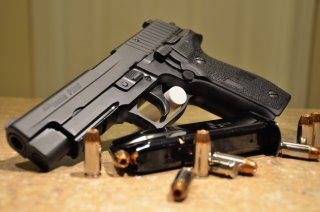Over and Out: The Navy SEALs Have Had Enough of the P226 Pistol
At its heart, the Mk 25 P226 was still the same double-action/single-action pistol that the original P226 was.
Here's What You Need to Remember: It is known is that Glocks are far cheaper due their plastic frame and optimized manufacturing process. While Sig Sauer has created an excellent alloy-framed double action/single action pistol in the Mk 25, the general move to a striker triggers and the affordability of the Glock probably has doomed the Mk 25 to be a piece only for collectors and civilian marksmen looking for a pistol with some Navy SEAL heritage.
While the Sig Sauer P226 is used by many militaries and agencies worldwide, one of the most famous users of the pistol is the U.S. Navy SEALs, which used the P226 up until they switched to the Glock 19 around 2015. But the pistol has constantly evolved throughout its service with the Navy SEALs: there are three practical generations of P226s that have been used by the SEALs.
The first generation of P226 was adopted by the Navy SEALs following some embarrassing issues that happened during the XM9 pistol trials that resulted in the adoption of the Beretta 92 by all services. A slide on a Beretta failed and hit a Navy SEAL in the face, causing him minor injury. While Beretta would address this flaw in the issued version of the M9, the damage was already done, and the SEALs chose the P226, a runner up design, as their primary service pistol.
However, poor experiences with 9mm ball ammunition would lead special units to develop the Mk 23 Offensive Handgun Weapon System, chambered in .45 ACP. These hulking pistols would go on to be used by the Navy SEALs, under the designation Mk 23, but was soon found to be too big and heavy for practical use. So, in the late 1990s, the Navy decided to buy more P226s, but designated them Mk 24, as they were the next pistol adopted after the Mk 23.
The Mk 24 differed from earlier P226s as it was purpose built for the SEALs and the demands for their environment, featuring a chrome lined chamber and barrel, a proprietary Sig rail and a new finish on the slide. The characteristic anchor was also present on the slide, indicating that the pistol was purpose-built for Naval Special Operations Forces.
However, the SEALs again would request a dedicated suppressed .45 caliber handgun. H&K would answer the call again with a the HK45C, which was adopted, confusingly, under the designation Mk 24 Mod 0.
But the P226 remained in the role of a standard issue sidearm for the SEALs when missions didn’t require a .45. However, shortcomings with the 1990s Mk 24 design started to show up in the 2000s. The Sig rail didn’t work well with all accessories and the pistol didn’t have night sights. The design was revised again into the Mk 25 in 2011, which changed the rail into a standard M1913 Picatinny rail and added SIGLITE night sights to the pistol. A standard 2D barcode was also added to the pistol’s frame for inventory purposes.
But at its heart, the Mk 25 P226 was still the same double action/single action pistol that the original P226 was. As militaries became confident in the qualities of the Glock striker fired pistols, the Glock 19 appeared to be a more practical and affordable option for the SEALs. In the SADJ article linked above, the author mentions that Glock 17s were provided alongside Sig Sauer P226s at the 2012 Warrior Challenge at KASOTC in Jordan, suggesting that the Glocks were considered to be of similar quality and reliability to the Sigs.
It is known is that Glocks are far cheaper due their plastic frame and optimized manufacturing process. While Sig Sauer has created an excellent alloy-framed double action/single action pistol in the Mk 25, the general move to a striker triggers and the affordability of the Glock probably has doomed the Mk 25 to be a piece only for collectors and civilian marksmen looking for a pistol with some Navy SEAL heritage.
Charlie Gao studied political and computer science at Grinnell College and is a frequent commentator on defense and national security issues. This article is being republished due to reader interest.
Image: Wikipedia.

